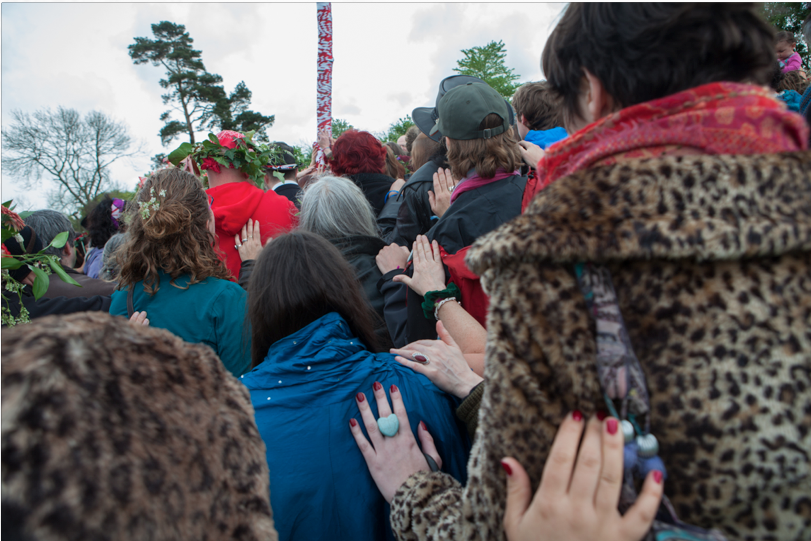Photos by Theo Cottle
Hands up if you had a Wiccan phase as a teenager. Because I definitely did. My evenings were spent rubbing patchouli oil on green candles and I once went to something called “Witchfest” in Croydon, England, where I learned about the best type of wood to carve a wand out of.
Videos by VICE
I quit witchcraft long before I was old enough to join a coven (most only accept members who are over 18). My spells weren’t working, my mom was mad that I’d inadvertently set fire to the carpet with a charcoal incense block, and I didn’t want to dress like a goth or a hippie, which felt like a prerequisite. But I do sometimes wonder what would have happened if I’d become a full-fledged pagan. Could I have developed healing powers? Would my wardrobe consist exclusively of crushed velvet? Would I own a bong shop by now?
Feeling nostalgic, I got in touch with a very kind, knowledgeable woman named Kala, who used to read my tarot cards. These days she describes herself as a seeker, but she was trained as a witch and has written lots of books on the subject. I told her I wanted to brush up on paganism, so she suggested I visit Glastonbury for the Beltane celebrations at the beginning of May. Marking the start of summer, Beltane is one of the largest festivals in the pagan calendar. The way Kala described it, it sounded a lot like The Wicker Man, minus the ritualistic slaughter of Christians. I was sold.
After a 5 AM start, we met at the Chalice Well, a sacred hole in the ground. As we gathered on the hillside, a Buddhist monk, a Druid, a Christian, and a Wiccan representing earth, air, fire, and water each invoked their different elements, saying the type of things you’d imagine they would. For example, “Today, we reenact the dance of creation, feeling our connection with the earth and calling on the energies of the universe.” It felt pretty nice that—for this one day in Glastonbury, at least—different religions could put aside their differences in the name of worshipping nature.
Following their speeches, the four representatives lit a bonfire—which represented creation—and asked three male volunteers to guide a maypole through a garland held by some female volunteers. It was probably the least subtle phallic reference I’d seen since the sledgehammer in the “Wrecking Ball” video. “Traditionally, Beltane was an excuse to get rat-arsed and have sex,” explained Kala.
As a red-and-white-ribboned maypole was set up beside us, we all took turns jumping over a fire, soundtracked by a bunch of people banging on drums. After everyone had had a little leap, it was time to head down to the Martyr’s Monument in the town center. There, just as the heavens began to open, we were introduced to this year’s May Queen and Summer King, who led a procession through town in which everything from the trees to the local recycling van were hailed and blessed.
We stopped off at the White Spring Well and Temple, where a couple of women got naked and splashed about in the water. The crowd was mostly an assortment of hippies letting it all hang out, along with a minority of people like me standing around in our coats and not really knowing what to do with ourselves.
By early afternoon I’d had a nice chat with the Archdruid of Avalon, but hadn’t had much luck speaking to any witches. Most of the people I met defined their spirituality in fairly woolly terms, describing themselves as nature worshippers or as belonging to “the religion of love.”
No witches meant no magic, just lots of women dressed as Maid Marian. I started to wonder if Beltane in Glastonbury is a bit like Christmas everywhere else—an excuse for a party, whether you believe in the legend or not.
As the procession reached Chalice Hill, I finally spoke to a bona fide witch, Sandie, who explained that that the celebrations were started about nine years ago by two covens who wanted to take May Day back from the church. After the town’s witches had taken a stand, the whole community got involved in celebrating the start of summer. On cue, the assembled crowd gathered as a group of four (all Druids, as far as I could tell), created a sacred circle, and erected the massive maypole that had been paraded through town. This ceremony felt a lot like the one that morning, only with slightly higher production values and a sword-bearer thrown in for good measure.
Strip away the novelty aspect, and attending a pagan ritual is a lot like attending any ceremony of a faith that you don’t belong to. Just as if I’d been attending a mass, a lot of the rhetoric went over my head, and I was glad when the sacred circle was disbanded for more maypole dancing.
As the sun came out, I accepted that I probably wasn’t going to experience any kind of epiphany at Beltane, but I am glad it exists. The mystery and magic that had first attracted me to witchcraft as a teenager was in short supply, but what I had found—lots of British eccentrics marking the changing of seasons—seems like a more sustainable basis for spirituality.
It’s obviously easy to be dismissive of anyone wearing a cloak, but a community coming together to celebrate nature is probably about as innocuous as religion is likely to get in 2014. And a part of me hopes that long after global warming has left all our major cities underwater, this lot will still be gathered on a hill somewhere worshipping the old gods in their own naked, dancy way.
Follow Joe Stone and Theo Cottle on Twitter.




















